How to Travel to Patagonia
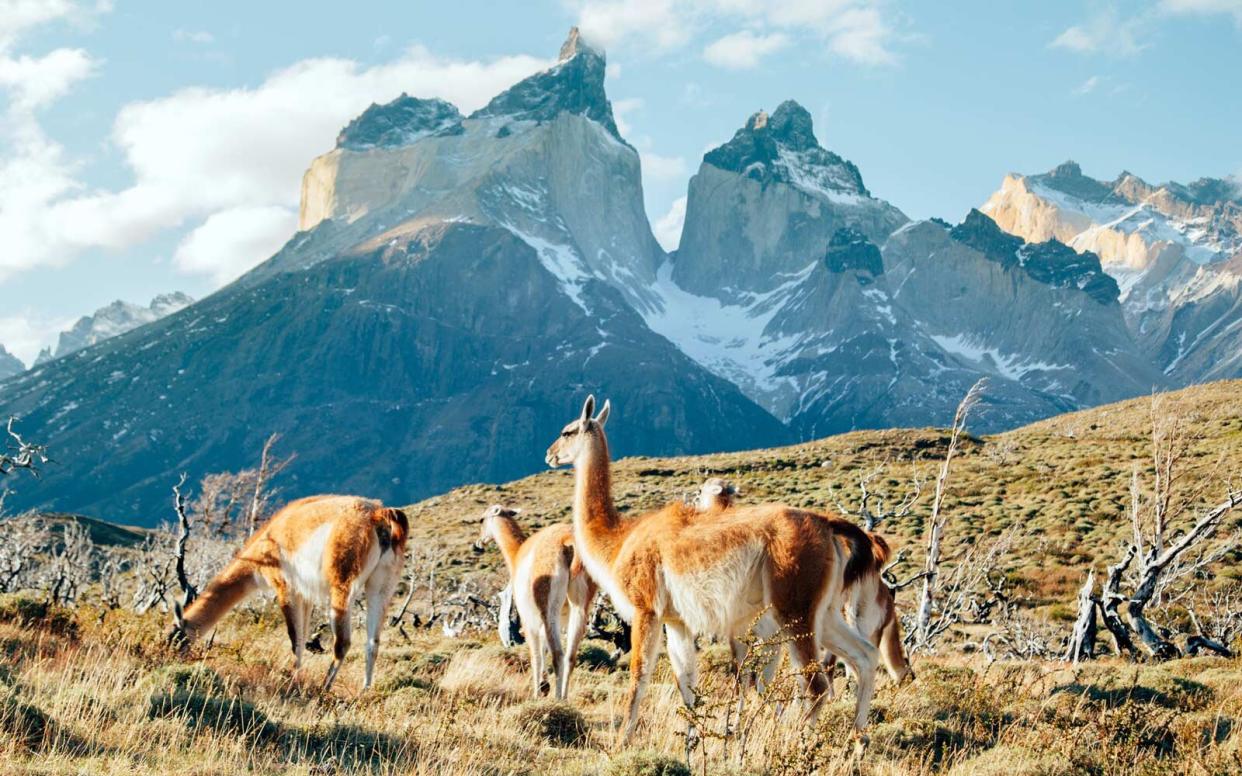
Getty Images/iStockphoto
Southern Patagonia, which stretches across Chile and Argentina, has long lured travelers to what is very nearly the end of the world with its storied peaks carved by age-old glaciers and spellbinding landscapes. Here, in the countries' national parks, are snow-capped mountains, cobalt fjords, and old-growth forests. At the southernmost tip of the Americas, icebergs rupture with a dramatic roar from ancient, massive glaciers.
Torres del Paine National Park in Chile and Argentina’s Los Glaciares National Park are the region’s top highlights, attracting hundreds of thousands of visitors per year. For a complete Patagonian travel journey, combine visits to both halves of the region. Of course, doing so requires a lot of logistical planning — especially during the high season. Here’s a comprehensive tip sheet to help you maximize your travels in this remote corner of the planet.
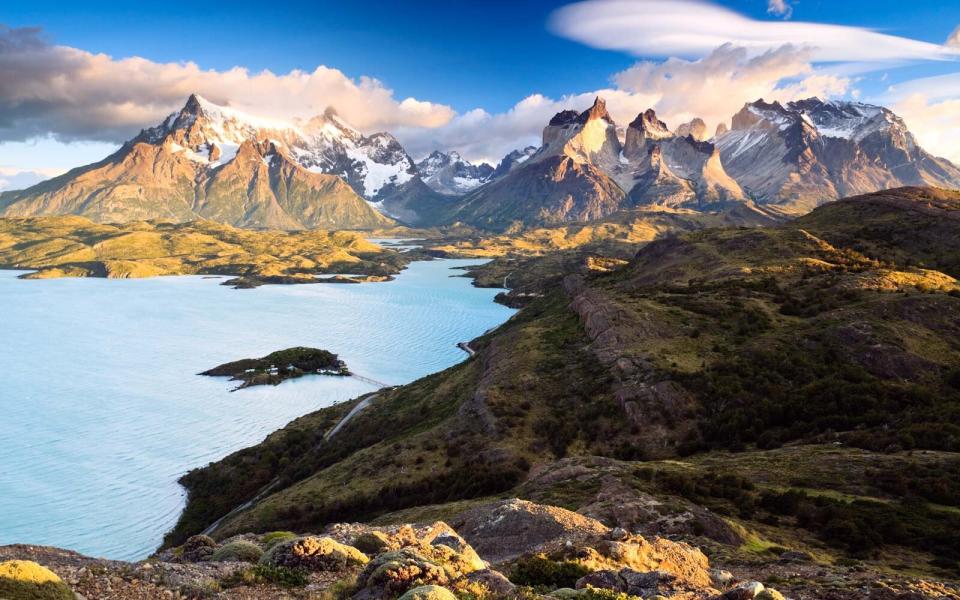
Getty Images
When to Go
In El Calafate and Torres del Paine, hotels normally operate from the Southern spring to fall (mid-September to early May). Just a few lodgings remain open year-round, such as the Explora hotel.
To avoid the crowds and still experience good weather, visit during the spring when the flowers are in bloom, or fall when the leaves are a fiery mosaic of red, orange, and yellow. The summer months (December to February) have the mildest weather, but keep in mind that temperatures rarely go above 70 degrees and the winds are strong.
Travelers should be aware that the weather in Patagonia is highly unpredictable, particularly in spring and early summer. Weather and temperatures can fluctuate without warning and violent storms can sweep in from the Pacific. It’s helpful to pad your schedule with additional days in case you encounter inclement weather.
How to Get There
Since distances are quite large in Chile and Argentina, you will need to fly to Patagonia (unless you have several weeks to spare for a road trip). Airline seats fill up quickly during peak season (December to February), so you should purchase tickets as far in advance as possible: Six months is ideal. For other months in the high season (October until early May), book three months ahead to avoid steep fares and limited options.
In Chile, LATAM Airlines serves southern Chilean Patagonia year-round with daily flights between Santiago and Punta Arenas with a flight time just over three hours.

Getty Images/iStockphoto
Sky Airlines, Chile’s low-cost provider, also flies non-stop between Santiago and both Puerto Natales as well as Punta Arenas for generally lower fares than LATAM. Puerto Natales fares are cheapest when the flight route is published around August each year. Driving time is three hours between Puerto Natales and Punta Arenas, two hours between Puerto Natales and Torres del Paine National Park, and five hours between Punta Arenas and the park.
In Argentina, meanwhile, Calafate and Ushuaia are the primary entryways. These destinations are serviced by LATAM Airlines and Aerolineas Argentinas.
During the tourist season, LATAM Airlines offers daily flights from Buenos Aires to El Calafate Airport (an easy 3.5-hour trip) with increased service during the high season. Flights are also available from Buenos Aires to Ushuaia and the trip is just shy of four hours in duration.
Aerolineas Argentinas also flies from Buenos Aires to Calafate and Ushuaia and between Ushuaia to Calafate. Los Glaciares National Park, home to the famous Perito Moreno Glacier, is an hour drive from El Calafate Airport. Another popular destination in this region is the trekking mecca El Chaltén, a three-hour drive from El Calafate Airport.
How to Get Around
Most luxury hotels in Southern Patagonia include transfers to and from the airport, as well as transportation for daily excursions.
Traveling between Chile and Argentina can be done easily by land or sea. Unfortunately, there are no flights between Puerto Natales or Punta Arenas to El Calafate or Ushuaia.
For an overland trip, you’ll need to organize a private transfer or catch a bus. The drive takes approximately five hours to cross the border between Argentinian Cancha Carrera and Chilean Cerro Castillo pass, all while traveling along the Patagonian steppe. It’s the same route in either direction you’re traveling.
There are several reputable bus companies that connect Puerto Natales and El Calafate daily, including Buses Fernandez and Buses Sur. The transfer takes five to seven hours, depending on the time spent at customs. Tickets can be purchased either online or at the bus station. Book at least one month in advance, especially during high season.
By sea, Australis cruises run from the end of September to the beginning of April connecting Punta Arenas and Ushuaia. The expeditions navigate fjords, Avenue of the Glaciers, the Strait of Magellan, and Cape Horn.
What to Pack
In Patagonia, travelers will need to be ready for all kinds of weather. Since temperatures can vary between 5 and 70 degrees Fahrenheit in the course of a single day, it’s crucial that travelers layer clothing. A waterproof jacket and trekking boots are highly essential, as is sunscreen and a pair of quality sunglasses (the sun is extremely bright).
If you’re staying in upscale lodges, a suitcase is fine to bring, but a backpack is recommended for multi-day trekking. Smaller backpacks are ideal for full or half-day excursions. Many upscale hotels provide personal water bottles and trekking poles.
Packing Essentials:
Long thermal underwear that wicks perspiration
Water repellent trekking pants
Light pullover or sweatshirt
Fleece or down liner
Waterproof parka or weatherproof jacket
Hat for sun protection
Sunglasses
Sunscreen
Liner or wind stopper gloves
Waterproof trekking boots
Long trekking socks
Neck gaiter
Bug spray
Headlamp
Trekking backpack or day pack
What to do in Chile
Travelers flock to Southern Patagonia to experience the otherworldly beauty of Torres del Paine National Park and spot Patagonia’s wildlife including the Big Five: pumas, llama-like guanacos, South Andean deer known as huemul, Andean condors, and the ostrich-like rhea, or ñandú. There are also flamingoes, foxes, penguins, and more than 100 species of birds. Several tour companies offer multi-day puma-tracking safaris through the park.
Visitors will also want to explore the park’s old-growth forests. In the canopies of primeval southern beech trees (lenga, coihue, ñire) you can spot Magellanic woodpeckers and Austral parakeets.
Full and half-day treks along the famous “W” Circuit (named for the shape of the route) offer one-of-a-kind vistas of sweeping freshwater lakes, teal lagoons, ice floes, and glimmering glaciers. The “W” Circuit is a 43-mile trek that, over the course of four or five days, visits the park’s major attractions and can be walked with overnight stays in refugios (basic dorm-style shelters) or campsites.
Stroll through the colorful fishing town of Puerto Natales, or explore the region’s labyrinth of scenic fjords, where immense glaciers and unusual marine life can be admired from the deck of a boat. On the shores of Punta Arenas, visit penguin colonies at Seno Otway or Magdalena Island and look out for sea lions and whales that populate the waters. You can also kayak the Strait of Magellan.
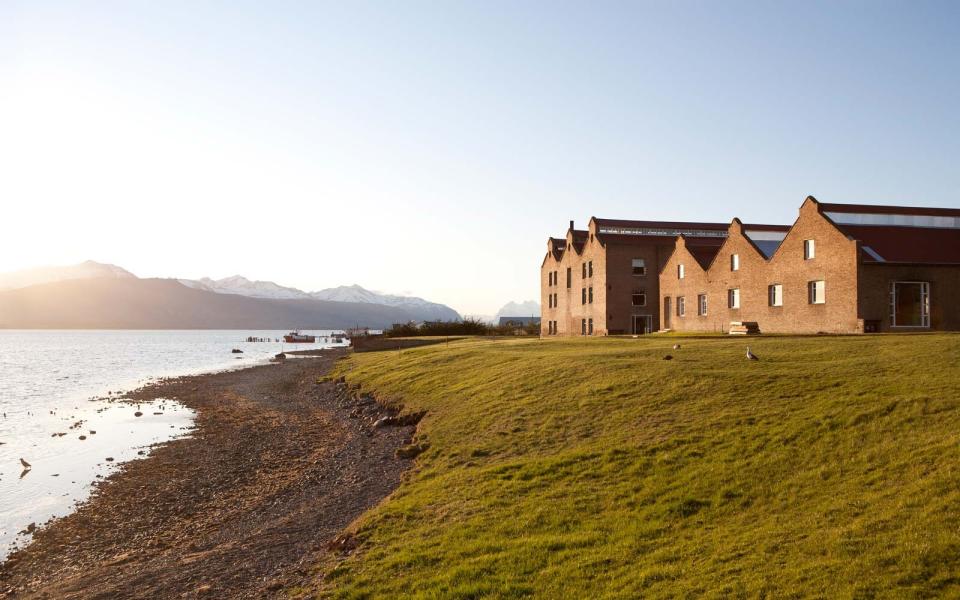
Getty Images/Lonely Planet Images
Where to Stay in Chile
Torres del Paine’s luxury lodges offer all-inclusive packages that incorporate airport transfers, a wide range of full and half-day excursions, and three gourmet meals per day with premium wine and cocktails. Explora is the pioneer of luxury lodges in Southern Patagonia — they offer over 50 explorations led by experienced guides. Fourteen exclusive villas are the signature of Awasi, where guests have their own private guide and four-wheel drive vehicle to explore the scenery at their own pace.
Overlooking Lake Sarmiento and Paine Massif, Tierra Patagonia subscribes to an adventure spa philosophy, where guests are encouraged to unwind after jam-packed days of adventure.
For glampers, the sustainable EcoCamp is a geodesic dome hotel tucked in the middle of the park. Accommodations range from basic to over-the-top, two-story heated tents that boast private terraces, private bathrooms, and ceiling windows facing upward to the Patagonian sky. Assisted camping experiences across the park’s trekking loop can be easily coordinated by operators like Fantástico Sur, Cascada Expediciones, Mountain Travel Sobek, and Swoop Patagonia.
A number of upscale properties are located in and around the colorful fishing town of Puerto Natales. The Singular Patagonia, a property situated on the banks of the Last Hope Sound, is a century-old national monument that’s been refurbished with industrial-chic accents.
At Lakutaia Lodge, on Navarrino Island next to Cape Horn, guests are deeply immersed in the surrounding parklands, glaciers, and fjords. But the real draw for adventurers is the opportunities to helifish and heliski.
What to Eat and Drink
Most of the lodges on private reserves offer full room and board, and employ talented chefs who take advantage of locally-sourced ingredients like white strawberries, rhubarb, seaweed, Patagonian honey, and gamier specialties like guanaco and Patagonian hare.
From the sea, try South American king crab, snook-and-hake ceviche, conger eel, robalo, hake, muscles, choritos (Callao-style steamed mussels), and oysters. Wash it all down with Chilean pisco sours or a bottle of reserve Chilean wine.
Day Trips from Chile
Hotels offer a staggering array of full and half-day excursions for every interest and fitness level that include mountain trekking, horseback riding, cycling, kayaking, sailing scenic fjords, and glacier cruises, among others.
The world-famous trek to the base of Torres del Paine is a must-do. It’s a challenging, eight-hour hike round-trip, but a clear view (weather depending) of the granite spires rising from the turquoise glacial lake is an ample reward.
One of the area’s most popular hikes is the Mirador Las Torres, which crosses the beautiful Pehoe Lake for views of the French Glacier calving from a natural amphitheater.
Take a zodiac voyage across Grey Lake to see the glistening Grey Glacier up close, or visit the Balmaceda and Serrano Glaciers from the wharf in Puerto Natales.
Spend the day with Chilean cowboys at the family-run Estancia Mercedes for horseback riding along fjords.
General Tips for Visiting Chile
When visiting during Chile’s summer months, beware of biting midges. Spray yourself with natural insect repellent at regular intervals and wear light-colored clothing and long sleeves, as these small flies are attracted to dark colors.
If you are an avid hiker, avoid heavy backpacker crowds in Torres del Paine by traveling in November or April.
On challenging treks, opt for two trekking poles. It will save your knees on the descent.
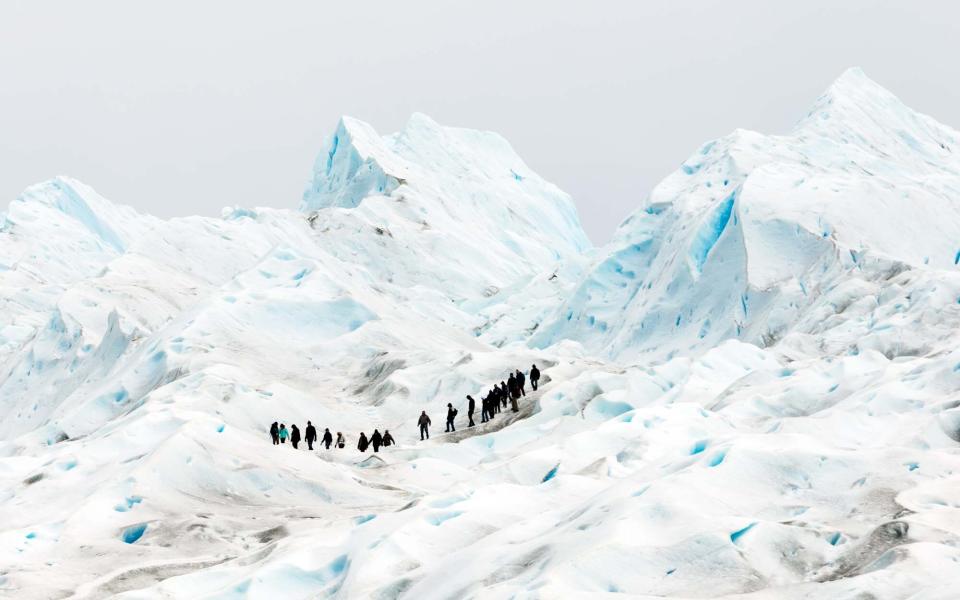
Getty Images/Perspectives
What to Do in Argentina
Over 100,000 visitors converge at the 97-square mile Perito Moreno Glacier — a declared UNESCO World Heritage Site in Los Glaciares National Park — every year. Located near El Calafate, it’s one of the world’s most exceptional ice fields and one of only three Patagonian glaciers that continues to grow.
Boat cruises on the lake will take you close enough to witness colossal icebergs spontaneously fragment from the Perito Moreno Glacier and into Lake Argentino below. Some tours give visitors a chance to hike out onto the glacier wearing metal crampons.
Visiting the area’s historic estancias offers travelers a glimpse into the rural life of Patagonian ranchers. The century-old Estancia Cristina on Lake Argentino and Nibepo Aike, a working cattle ranch near El Calafate, are destinations in their own right. Unspoiled landscapes and opportunities to hike, horseback ride, and visit the area’s stunning glaciers are abundant.
Three hours north by car from El Calafate is the laid-back hiking hamlet of El Chalten, famous for its towering Fitz Roy mountain peak. The tiny frontier town is dotted with picturesque chalets and a network of scenic trails that suit every skill level.
You’ll travel to the “end of the world” in Tierra del Fuego. Its capital city, Ushuaia, is a port of arrival or departure when traveling by sea between Argentina and Chile. Take a boat cruise or catamaran trip to see penguins, sea lions, and cormorants inhabiting the legendary Beagle Channel made famous by naturalist Charles Darwin on his Voyage of the Beagle in 1831.
Tierra del Fuego National Park offers a lush sub-Antarctic rainforest shaded with beech trees, while Glacier Martial offers a panoramic view of Ushuaia and the channel. International anglers make pilgrimages to the banks of the Rio Grande in the hope of hooking its record brown trout.
Where to Stay in Argentina
While El Calafate’s main street — Avenue del Libertador General San Martín — is lined with quaint shops and restaurants, the surrounding town lacks the same charm. Two pleasant and affordable places to stay on the southern shore of Lake Argentino are Esplendor Calafate and Xelena.
Eolo Lodge, located 30 minutes west of El Calafate, is built on 10,000 acres of arid steppe and pampas grass with lake views. Antiques, heavy wooden furniture, and mismatched dishware give the lodge a cozy country atmosphere. Nearby, guests can take guided treks, go horseback riding, mountain biking, and birdwatching. The hotel can also arrange excursions to the Perito Moreno and Upsala Glaciers. Book one of the corner suites for a spectacular view.
Travelers can book multi-night stays or take full expeditions from El Calafate to Estancia Cristina, a 20th century sheep ranch only accessible by boat across Lake Argentino. Set on 54,000 acres of wild Patagonian landscape, the preserved estancia offers a menu of excursions that combine trekking, 4x4, and sailing among icebergs near the Upsala Glacier. Fishermen, meanwhile, can ride horseback to glacial lakes near the hotel to catch Chinook salmon and rainbow trout.
Estancia Nibepo Aike is an authentic working ranch founded by a Croatian pioneer at the turn of the 20th century. The estancia still raises cattle and sheep, granting guests the unusual opportunity to shear sheep, learn gaucho (cowboy) skills on horseback, and to sample a traditional prepared asado (barbecue) of Patagonian lamb. Overnight guests can explore the hidden glaciers Gorra, Frías, and Dickson.
Between El Chalten and El Calafate, you can stay at Estancia Helsingfors, a rustic lodge set on the shores of Lake Viedma with great food and stunning mountain views. Five hours from El Calafate on a pristine private nature reserve along Lake San Martin sits Estancia El Condor, named for the nearby condor nesting sites.
Los Cerros, located on a hilltop overlooking El Chalten, is the most luxe option in a backpacking haven brimming with hostels. And the exclusive Aguas Arribas Lodge, an hour drive north of Chalten, is a secluded lakeside retreat looking upon the north face of Mount Fitz Roy.
In Ushuaia, luxury properties Los Cauquenes and Arakur Ushuaia Resort & Spa both overlook the Beagle Channel and offer guided wilderness hikes and sailing excursions.
What to Eat and Drink
Most estancias offer full board with three gourmet meals per day, but there are some local delicacies you must check off your list.
El Calafate gets its name from the calafate berry (barberry), and there is a local legend that says whoever eats a calafate berry will return to Patagonia. Try calafate gelato, calafate liqueur, and delicious jams made from chaura (prickly heath) and zarzaparrilla (wild currant). For grilled cuisine visit La Tablita, and stop at Abuela Goye for an artisanal alfajor and other chocolate treats.
Experiencing an authentic Patagonian asado is a must-do at one of the estancias. Watch the asadors cook local Patagonian lamb on an iron cross over a live fire and enjoy it with a glass of Patagonian pinot noir or a Mendocinean mablec in hand.
In Ushuaia, dine at the restaurant Kaupe: It’s considered one of the best restaurants in Argentina.
Grab an artisanal beer at Cerveceria Beagle, which brews its own beer using meltwater from nearby glaciers.
Arguably the most important and culturally significant of all Argentine drinks is mate. Sipping mate tea is a long-held social ritual that consists of drinking yerba mate (a caffeine-rich blend of dried herbs) steeped in hot water inside a hollowed gourd or wooden mate cup through a bombilla (metal straw). Try adding a little sugar if the taste is too bitter for your palate.
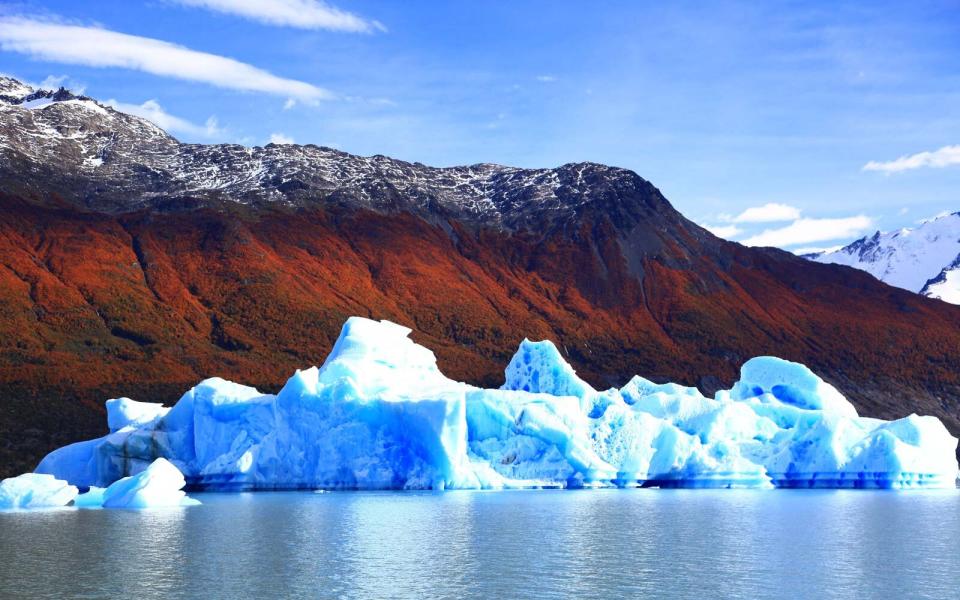
UIG via Getty Images
Day Trips from Argentina
A trip to Perito Moreno Glacier in Los Glacieres National Park is one of Patagonia’s most iconic excursions. Hielo & Aventura offers the best big ice and mini-trekking adventures.
Marpatag’s stylish Leal Cruiser takes guests on an all-day glacier adventure sailing along Lake Argentino and visiting the Upsala, Spegazzini, and Perito Moreno glaciers.
A full-day excursion to Estancia Cristina includes a boat ride past glaciers and waterfalls. Cañadon de los Fosiles is a five-hour trek from the estancia with views of Lake Guillermo and the Upsala Glacier, before descending through a valley of ancient fossils.
El Chalten offers a variety of scenic day hikes including the Cerro Torre Trek, an easy six-hour hike, and the more challenging Monte Fitz Roy Trek, an eight-hour hike to Laguna de los Tres. You can also ice hike atop the Viedma Glacier.
In Tierra del Fuego, look for marine wildlife in the Beagle Channel or visit panoramic lookout points on hikes through Tierra del Fuego National Park.
General Tips for Visiting Argentina
Perito Moreno Glacier’s big ice treks have strict age limits — typically from 18 to 65 years old — that differ by tour.
If you plan to spend a night at Estancia Cristina, you will need to overnight in Calafate before and after, as the boat departs early in the morning and returns in the late afternoon.
Avid hikers should visit El Chalten in November or April to avoid heavy crowds.
Outdoor equipment is expensive in Argentina, so be certain you’re well equipped before traveling.
Visas
Capital cities Santiago, Chile and Buenos Aires, Argentina both serve as gateways to Southern Patagonia. As of recently, Americans do not need a visa or have to pay a reciprocity fee to enter either country.
Which side to start on is a matter of personal preference, and also depends on what other destinations are included on your itinerary. However, if you plan to visit both countries, you can start in one city and finish in the other, so you have the opportunity to experience both.
Patagonia Cruises
Australis offers expedition cruises that specialize exclusively in the southern shores of Patagonia. Four to seven-night itineraries can be booked round-trip, or one way to or from Punta Arenas and Ushuaia. The cruise navigates the Strait of Magellan, the Beagle Channel, and stops at Cape Horn National Park, offering travelers the opportunity to go ashore and explore.
Daily zodiac rides explore fjords and glaciers, and cruisers will spot plenty of wildlife including penguin colonies and elephant seals. Each cabin, ranging from 160 to 220 square feet, has a picture window and a private bathroom with a shower.

